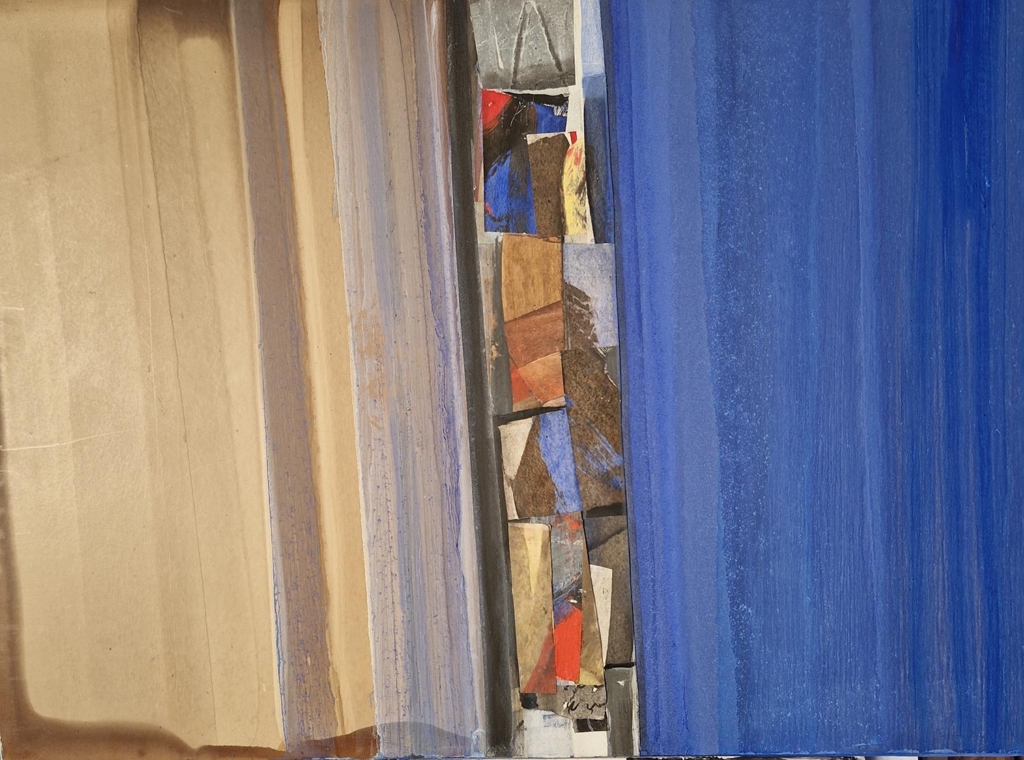When Carles Guasch speaks of painting, he does not do so as someone who describes a technique or a style, but as a way of being in the world. His work does not seek to please or decorate: it is born of an inner drive. “The need to communicate drove me to become a painter,” he confesses. “Perhaps because of shyness, because I had a whole inner world that I needed to express in some way. Guasch does not paint to entertain. He paints because not to do so would be to betray himself. And it shows. Each of his canvases is the result of a silent struggle between form and emotion, between structure and freedom. “I use a lot of blue, ultramarine and cobalt, more as a noun than as an adjective,” he explains. From there, he unfolds a chromatic symphony made up of complementary reds, yellows that peek timidly, greys… Like musical notes that repeat and intertwine. Like an abstract melody. He calls it “sequences”.
Born on the island and trained first at the School of Arts in Ibiza and then at the Massana School in Barcelona, Guasch is one of the most representative artists of contemporary abstraction on the island. But it would be a mistake to understand him only from the local prism. His work has traveled, and a lot, with exhibitions throughout Spain, Europe and the United States, and an international projection that co-exists with his will of rootedness. Ibiza is not only his home, but also a fundamental part of his artistic essence. His first exhibition, no less than at the Ateneo de Barcelona, marked him to dedicate himself fully to painting, “it was like a projectile that launched me into the following years,” he recalls.
Founder of the EivissArtGrup in 2011 along with 10 other abstract artists including with Gilbert Herreyns or Tur Costa, president of the artistic association AAVIB for 10 years and president of the Premis Vuit d’Agost de Pintura, Guasch remains today deeply involved in the artistic becoming of the island. “In Ibiza there is a lot of art, since the 60s, but it has not been given the importance it had. The focus has always been on leisure, and that has overshadowed the island’s creative culture.” With a critical lucidity that is not at all complacent, he denounces the disconnection of some galleries with the local reality and regrets the absence of an art pedagogy that educates taste, that teaches how to look. “Some very exclusive galleries open on the island, which have no contact with Ibiza, they are here because Ibiza has a clientele with a lot of money, but they use Ibiza as a stage, they don’t get involved with the culture here.” And he qualifies, “When I started there were fewer painters, but there were not so many fans. Even people who retire and start painting want to exhibit”. A paradox that he summarises in the fact that on the island “there is a lot of ordinary art on the island but also a lot of high skilled art too now”.

His discourse is firm, but not elitist. In fact, he defends the subjectivity of art and the viewer’s freedom. “Abstraction is for everyone to see what they want, or not to see anything and like it”. That is why he has stopped giving titles to his works: “they condition the viewer”. And that is also why he distances himself from ephemeral fashions and empty spectacle: “Where is the art in all this?” he asks himself in the face of certain media provocations, such as Maurizio Cattelan’s famous banana sold for more than 6 million dollars. In contrast, he points out how his artistic references, such as Tapies or the artists of the El Paso group, are still absolutely valid today. And, above all, he is deeply concerned about a world that is becoming more and more materialistic and where young people are increasingly disconnected from the art world. “In the exhibitions I always see older people” and adds “young people now only want to be influencers, but to contribute what?”
His holds a commitment that admits no concessions and a fierce demand. “I have destroyed a lot of work that I am sure someone else would want to have because I was not convinced.” Each painting is the result of days of research, corrections, intuitions. And only when he feels that the work has reached a chromatic and emotional balance does he consider it finished. Over the years he has maintained a stylistic coherence that allows him to be recognised anywhere, without ever repeating himself. “I work within the same language and point of view. It’s not that I always do the same thing, it’s that I have my own style.” And that style, elegant, dense, luminous, has been the vehicle with which he has dialogued with other artists, with poetry, with landscape, with history.
He has illustrated books, such as the haikus of “Des de l’illa” with his friend Nora Albert, probably his most beloved collaboration, and has been a promoter of collective projects, curator of exhibitions. Because beyond his facet as a creator, Carles Guasch has also been, and continues to be, a key figure in the cultural life of Ibiza. There is something profoundly honest in his look, in his way of speaking and painting. He does not seek applause or headlines. He seeks to move, to provoke genuine emotion, to awaken something intimate and unrepeatable. As he himself says, “the most important things in life cannot be explained. They are sensations. And art, if it’s good, doesn’t need explanation either.”










